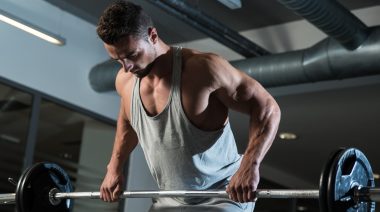You might know the deadlift as a member of the “big three” powerlifting movements, along with the squat and bench press. As the least complex of the competition exercises, the deadlift typically allows lifters to move the heaviest weight. This hip-dominant pull from the floor is arguably the purest expression of lower body strength and total body loading capacity.
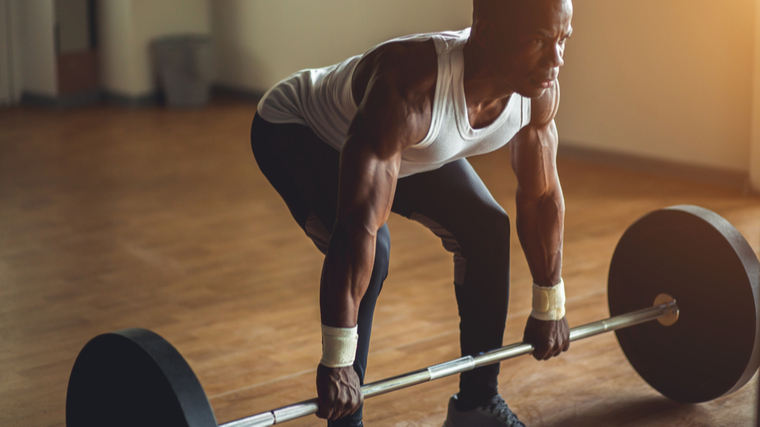
But deadlifts aren’t just for powerlifters. They provide opportunities for all lifters to improve their strength, resiliency, physique, and overall toughness. Read on for six lesser-known benefits of the deadlift. Also included is a no-nonsense deadlift demo, several common variations, helpful tips, and programming recommendations.
Deadlift Details
- Benefits of the Deadlift
- How to Deadlift
- Deadlift Variations
- Deadlift Form Tips
- How to Program the Deadlift
Six Benefits of the Deadlift
In case no one told you, if you’re not training to be a competitive powerlifter, you don’t have to deadlift. But, you probably should anyway. Here are six benefits of deadlifting even if you’re not planning to get onto a competition platform.
Shoulder Stability
The ability to generate tension around your shoulders is essential for lifting and day-to-day endeavors. The deadlift is an under-appreciated method of training shoulder stability.
Performed properly, the deadlift requires “packed shoulders” — a state of muscular tension around the shoulders and upper back. In fact, many common deadlift cues, such as “squeeze your armpits,” “crush oranges,” and “bend the bar,” are intended to reinforce co-contraction of the muscles around the shoulders. These muscles include the lats, teres major, deltoids, rotator cuff, and others.
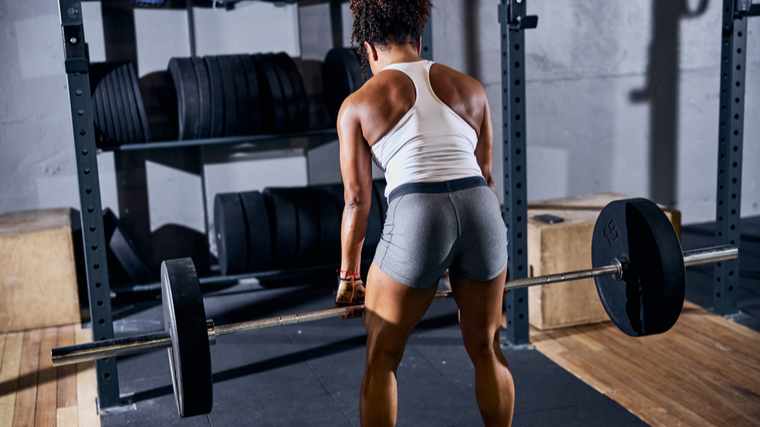
Because the force of muscular co-contraction is directed toward the shoulder’s “socket,” it counteracts dislocating forces, such those imposed by holding a barbell during the deadlift. (1) Ultimately, this muscle action is thought to shield structures of the shoulder from excessive stress and stain by maintaining or restoring mechanical congruency of the shoulder. (1)
Training the shoulder muscles to effectively co-contract is not only important for lifting heavy weights — it may be related to better shoulder health. For example, increased co-contraction of the teres major and latissimus dorsi has been associated with improved shoulder pain and function among those with rotator cuff-related shoulder pain. (2) Due to its high potential for loading, the deadlift may be among the best exercises for training shoulder stability with heavy loads.
“Forced” Flexibility
Tight hamstrings are common. Fortunately, there’s a more efficient way to increase flexibility than spending your time stretching, and it involves eccentric training at long muscle lengths. (3) The deadlift provides the hamstrings with both stimuli.
During the lowering (eccentric) phase of the deadlift, the hamstrings experience progressive lengthening across the hip while actively generating muscle tension. The greatest total tension in the hamstrings occurs toward the bottom of the movement, just before the plates reach the floor. These features impose a massive stimulus for improved hamstring flexibility.
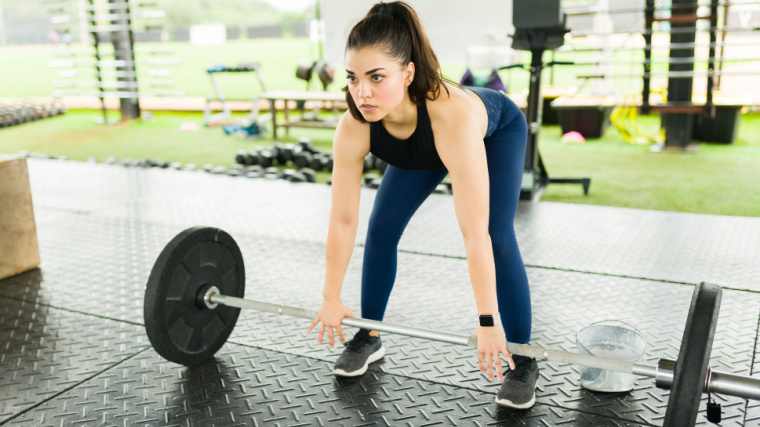
Substitute your classic “sit-and-reach” stretch with full range of motion deadlifts to reap flexibility and strength benefits. Not to mention, the deadlift is likely to stimulate appreciable hamstring size gains. The hamstrings are an underappreciated contributor to lower body aesthetics, which brings us to the next benefit.
Nails Neglected Aesthetic Muscles
The deadlift is commonly thought of as a “shotgun” exercise. It hits many muscles, while isolating none. Closer analysis reveals the deadlift robustly trains multiple muscle groups more intensely than other common exercises. (4) Fortunately for aesthetics-oriented lifters — those who train to look like they lift — the deadlift excels at developing key areas of the physique.
When it comes to leg size, the quadriceps get most of the attention. They’re the most visible thigh muscle when the legs are viewed head-on, while the hamstrings are much more impressive when the legs are viewed from the side. Anyone can develop a decent set of quads with enough leg extensions, but well-developed hamstrings are truly earned. The deadlift is a great place to start.
A muscle modeling study showed that deadlifts train the hamstrings with greater force and across a greater range of motion than good mornings and split squats. (4) These features are likely to result in superior hamstrings hypertrophy. (5)(6)
The muscles of the forearm, which primarily act on the wrist and hand, are visible in a wider variety of settings than other “glamor muscles.” Well-developed forearm muscles project power and capability. Fortunately, the deadlift is a grip-intensive exercise. Regular high-intensity deadlift sessions are certain to thicken and sculpt your forearms to ultimately impress your fellow business-casual colleagues.
Teaches You To “Grind”
Barbell speed slows dramatically when you’re moving heavy weights and as you approach the end of high-effort sets. This is a normal and expected phenomenon. Barbell speed slows and, if the set is continued, failure ultimately occurs. However, the ability to “grind through” very slow repetitions, at bar speeds where others would fail or quit, is seen almost exclusively in experienced lifters. (7) Grinding is a skill, and you can build it with the deadlift.
When approaching muscular failure or using one-repetition maximum loads, the deadlift is among the slowest barbell exercises. (8)(9) As a relatively low-complexity lift, the deadlift is ideally suited to training yourself to push through grinding reps while maintaining viable form.
Unlike exercises that place the lifter under the bar, like the squat or overhead press, the deadlift does not require a spotter. If you happen to lose form or push too far, you can simply set the bar back on the ground.
Do not think of these hard deadlifts as “training for toughness” but rather as targeted skill training at the edge of your physical capacity — Keep bracing, keep tension, keep composure, and keep pulling. The skill of “grinding” will pay dividends during your next one-repetition maximum attempt and during any high-effort training sessions.
Bone Density
Like muscle, bone responds to mechanical stimulation — It gets stronger in response to loading. (10) Progressive bouts of loading promote the activity of osteoblasts, the “bone building” cells, resulting in a net increase in bone mineral density.
The deadlift places compressive loads through much of the spine and lower body. Because it can be incrementally loaded with gradually heavier weights, it is ideally suited to build bone mineral density.
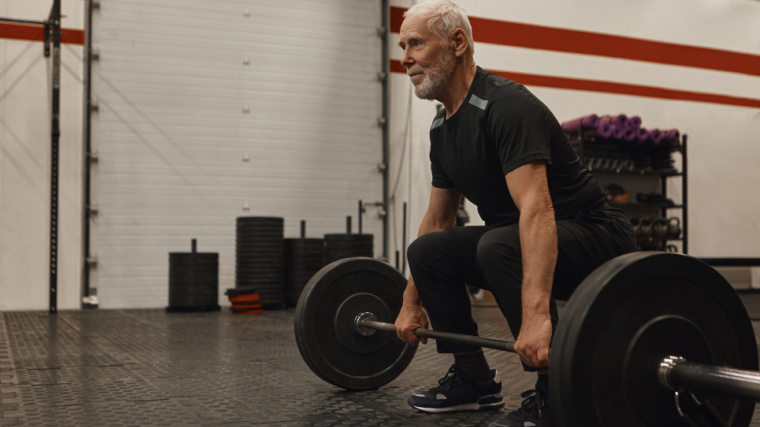
Increased bone mineral density is likely to occur alongside muscular adaptations (i.e. strength and hypertrophy), so healthy lifters do not need a special protocol to reap this benefit. Just remember, bone requires progressive loading and adequate recovery. Gradual increases in deadlift weight and/or volume is needed to promote ongoing adaptation. Cycling between moderate and heavy loads (e.g. 67-95% of one-repetition maximum) and deadlifting on non-consecutive days are also recommended. (10)
Betters Your Back
In some circles, deadlifts carry the erroneous reputation of being “bad for your back.” I struggled to recruit a sample of college students for a deadlift exercise study for this reason. Research from rehabilitation literature should prompt re-examination of the preconceived notions some hold about the deadlift.
Evidence suggests that deadlifts may be beneficial for individuals suffering from low back pain. (11)(12) Deadlifts performed comparably to more traditional low back rehabilitation exercises (i.e. low load core exercises) for improving pain and function. (11) Moreover, individuals with higher baseline hip and trunk strength may experience greater benefits from deadlifts compared to those with lower baseline strength. (13)
Ask your doctor if deadlifting is right for you. All back injuries are unique — If you are currently injured, you should check with a qualified sports medicine provider to determine whether your specific injury is likely to benefit from deadlifts. For healthy lifters, this information should cast the deadlift in a new light. If deadlifts are shown to help to address low back pain, they might be good for our backs.
How to Deadlift
To perform the conventional deadlift, you need a barbell and some plates. Incidental items, such as lifting straps, chalk, and a belt, are optional and may be used based on personal preferences and goals. Acceptable form, however, is non-negotiable.
- Place your feet under the bar at hip-width. The bar should be over the midfoot or arch of the foot.
- Push your hips back allowing only a small amount of knee bend. Grasp the bar at shoulder-width using a double-overhand or over-under (“mixed”) grip.
- Keep your elbows straight and your midsection braced as you lift your chest to pull the “slack” out of the bar. Create tension in your shoulders by squeezing your arms into your sides.
- Keep the bar close to your body and drive your heels into the ground to stand up.
- Once you achieve a fully upright position, reverse the movement to lower the bar to the floor. Push your hips back, allowing only slight knee bend. Once again, keep the bar close to your body.
Deadlift Variations
The conventional deadlift, despite all its benefits, is not mandatory. If the conventional deadlift no longer serves your goals, or if it feels like you’re pulling a square peg out of a round hole, it’s time to consider one of these common deadlift variations.
Romanian Deadlift
Training to build bigger, stronger, or more resilient hamstrings? If so, go with the Romanian deadlift (RDL). This variation is characterized by less knee bend. The RDL tends to keep the hamstrings at longer muscle lengths — a feature associated with flexibility gains, as previously discussed, and likely superior muscle growth. (2)(14)
Briefly, the repetition begins from the top with the barbell held at shoulder-width in front of your thighs. Fix your knees in a slight bend and perform the repetition by moving exclusively from the hips. Flex forward, lowering the bar toward the ground until you achieve a strong sensation of stretch in the hamstrings, or cannot go any lower without overtly rounding your back. Return to standing.
Trap Bar Deadlift
The trap bar deadlift is performed with a unique barbell — a trap bar or “hex bar.” While the conventional deadlift is performed with the weight held slightly in front of the body, the trap bar deadlift allows the lifter to stand between weight plates.
To perform the trap bar deadlift, the lifter grasps the handles, which are located alongside the body and oriented front-to-back. These handles may sit higher than the weight plates, which ultimately reduces the overall range of motion. (9)
The body position and handle design of the trap bar typically allows lifters to handle more weight and demonstrate higher peak power outputs. (9)(15) These features may be desirable if your goal is developing maximum strength or sport performance.
Moreover, the trap bar deadlift tends to place more demand on the quadriceps than the conventional deadlift. (15) Therefore, the trap bar deadlift may be a good “one stop” exercise for lifters who do not have the time or inclination to hit additional quadriceps exercises, such as leg extensions or squats, along with deadlifts on “leg day.”
Sumo Deadlift
Compared to the conventional deadlift, the sumo deadlift is performed with a wider stance and more hip external rotation. Rather than gripping the barbell outside of the knees, as in the conventional deadlift, grip is well-within the knees for sumo. These features change the relative contribution of lower body joints to the lift and may reduce demand on the low back.
The sumo deadlift requires greater knee extensor (quadriceps) contribution than the conventional deadlift, while requiring similar hip extension contribution. (16) Also, note the sumo deadlift requires substantial hip mobility and strength in multiple planes. Therefore, it has been suggested for lifters who possess substantial hip mobility and adductor strength. (17)
However, lifters who wish to develop these attributes may also benefit from the sumo deadlift, provided they scale the lift to their current abilities. This might be accomplished by elevating the barbell on small blocks and/or reducing the weight and building up gradually.
Deadlift Form Tips
The deadlift appears simple: Pick the bar up and lower it to the floor. But developing consistent and acceptable deadlift technique requires practice. Keep these simple tips in mind to flatten your deadlift learning curve and promote optimal performance.
Methodically Reset Before Each Repetition
Often, a lifter demonstrates clean technique on the first repetition of a set and then, form deteriorates during subsequent repetitions. To prevent this, take a moment to reset before each repetition.
The process of setting your grip, generating tension in your shoulder muscles, wedging in, bracing, and lifting the “slack” out of the bar should be dutifully repeated before the first repetition and before each additional repetition.
Don’t Fear the Mixed Grip
A “mixed grip” describes holding the barbell with an overhand grip with one hand and an underhand grip with the other. Although this grip typically allows lifters to handle more weight, some coaches dissuade mixed grip deadlifting for fear of biceps injury. Despite the possible risk, mixed grip deadlifts are extremely common in powerlifting competitions and in training.
While very rare, biceps brachii tendon injuries can occur during lifting. The common mechanism is during eccentric phase of resisted elbow flexion. (18) However, distal biceps tendon tears have occurred during the deadlift, which suggests deadlifting as another distinct injury mechanism. (19)
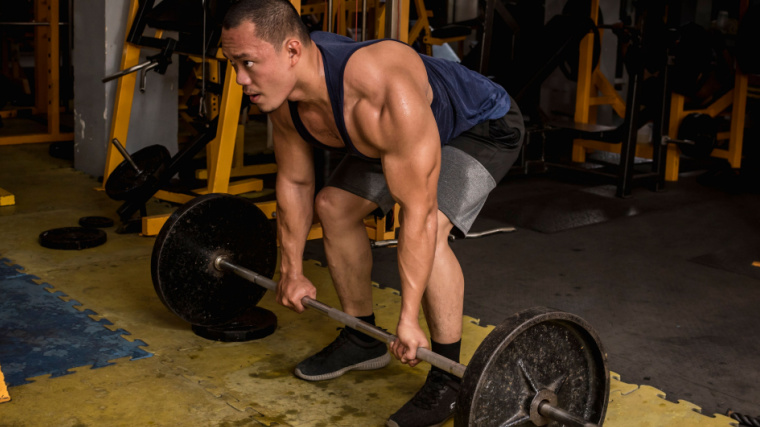
Researchers scoured YouTube for distal biceps injuries during the deadlift and a team of sports medicine physicians analyzed the videos. The team found twenty-five unique videos of probable distal biceps ruptures, and twenty-four of these occurred on the underhand side of a mixed grip deadlift. (19)
As the saying goes, you “could” drown in a bowl of soup. You “could” also tear your biceps during a deadlift. Does the presence of risk mean we should avoid mixed grip deadlifts, and chunky chicken noodle, for the rest of our lives?
Nearly all actions in lifting (and life) require risk/reward analysis. Resistance training is extremely unlikely to be injurious to healthy lifters. (18) Currently, little epidemiological evidence directly informs the risk of biceps injuries during deadlifts. But considering a dedicated research team was only able to find two dozen unique videos of mixed grip deadlift biceps injuries on YouTube, in an era where nearly all lifters film their lifts, suggests a very low rate of injury.
If you want to move big weights, you could use a double overhand grip on the bar with lifting straps to avoid the mixed grip altogether, but you might miss out on some forearm- and grip-building benefits. Regardless of your grip choice, using appropriate weight, gradually progressing, and ensuring controlled lifting technique are likely to reduce risk. And, let’s face it, these are things you should be doing anyway.
Programming the Deadlift
Getting the most out of your training requires attention to programming. Work toward your primary training goal while reaping bonus benefits of the deadlift with these programming parameters:
- For Strength: Prioritize heavy working sets of two to six repetitions at 85% or greater of one-repetition maximum.
- For Muscle Gain: Prioritize high-effort sets taken within three or four repetitions of failure. Although a wide range of repetitions and loads are effective for hypertrophy, moderate loads and set volumes are practical. (20) Prioritize sets of six to 14 reps using between 65-85% of one-repetition maximum.
- For Core and Lower Body Muscular Endurance: Albeit physically taxing, use 65% of one-repetition maximum or less, and aim for 15 or more repetitions per set.
Keep in mind the deadlift is a systemically-demanding lift. In most cases, it should be your primary lift of the session and completed toward the beginning of your workout. To organize and optimize your training, consider a workout split with intermittent deloads.
Deadlifts Done Purposefully
The deadlift is a classic barbell exercise with applications beyond the sport of powerlifting. From flexibility to physique development, the ancillary benefits of this classic lift support the role of the deadlift in nearly every lifter’s routine.
References
- Veeger, H. E. J., & Van Der Helm, F. C. T. (2007). Shoulder function: the perfect compromise between mobility and stability. Journal of Biomechanics, 40(10), 2119-2129.
- Overbeek, C. L., et al. (2018). Increased co-contraction of arm adductors is associated with a favorable course in subacromial pain syndrome. Journal of Shoulder and Elbow Surgery, 27(11), 1925-1931.
- O’Sullivan, K., McAuliffe, S., & DeBurca, N. (2012). The effects of eccentric training on lower limb flexibility: a systematic review. British Journal of Sports Medicine, 46(12), 838-845.
- Schellenberg, F., Taylor, W. R., & Lorenzetti, S. (2017). Towards evidence based strength training: a comparison of muscle forces during deadlifts, good mornings and split squats. BMC Sports Science, Medicine and Rehabilitation, 9(1), 1-10.
- Schoenfeld, B. J., & Grgic, J. (2020). Effects of range of motion on muscle development during resistance training interventions: A systematic review. SAGE Open Medicine, 8, 2050312120901559.
- Wackerhage, H., et al. (2019). Stimuli and sensors that initiate skeletal muscle hypertrophy following resistance exercise. Journal of Applied Physiology. 126, 30-43.
- Zourdos, M. C., et al. (2016). Novel resistance training–specific rating of perceived exertion scale measuring repetitions in reserve. The Journal of Strength & Conditioning Research, 30(1), 267-275.
- Lake, J., et al. (2017). Comparison of different minimal velocity thresholds to establish deadlift one repetition maximum. Sports, 5(3), 70.
- Lockie, R. G., et al. (2018). The 1 repetition maximum mechanics of a high-handle hexagonal bar deadlift compared with a conventional deadlift as measured by a linear position transducer. The Journal of Strength & Conditioning Research, 32(1), 150-161.
- Almstedt, H. C., et al. (2011). Changes in bone mineral density in response to 24 weeks of resistance training in college-age men and women. The Journal of Strength & Conditioning Research, 25(4), 1098-1103.
- Aasa, B., et al. (2015). Individualized low-load motor control exercises and education versus a high-load lifting exercise and education to improve activity, pain intensity, and physical performance in patients with low back pain: a randomized controlled trial. Journal of Orthopaedic & Sports Physical Therapy, 45(2), 77-85.
- Welch, N., et al. (2015). The effects of a free-weight-based resistance training intervention on pain, squat biomechanics and MRI-defined lumbar fat infiltration and functional cross-sectional area in those with chronic low back. BMJ Open Sport & Exercise Medicine, 1(1), e000050.
- Berglund, L., et al. (2015). Which patients with low back pain benefit from deadlift training?. The Journal of Strength & Conditioning Research, 29(7), 1803-1811.
- Maeo, S., et al. (2021). Greater hamstrings muscle hypertrophy but similar damage protection after training at long versus short muscle lengths. Medicine and science in sports and exercise, 53(4), 825.
- Swinton, P. A., et al. (2011). A biomechanical analysis of straight and hexagonal barbell deadlifts using submaximal loads. The Journal of Strength & Conditioning Research, 25(7), 2000-2009.
- Belcher, D. (2017). The sumo deadlift. Strength & Conditioning Journal, 39(4), 97-104.
- Hales, M. (2010). Improving the deadlift: Understanding biomechanical constraints and physiological adaptations to resistance exercise. Strength & Conditioning Journal, 32(4), 44-51.
- Golshani, K., et al. (2018). Upper extremity weightlifting injuries: Diagnosis and management. Journal of Orthopaedics, 15(1), 24-27.
- Kapicioglu, M., et al. (2021). The role of deadlifts in distal biceps brachii tendon ruptures: An alternative mechanism described with YouTube videos. Orthopaedic Journal of Sports Medicine, 9(3), 2325967121991811.
- Schoenfeld, B., et al. (2021). Resistance training recommendations to maximize muscle hypertrophy in an athletic population: Position stand of the IUSCA. International Journal of Strength and Conditioning, 1(1), 1-30.
Featured Image: Roman Chazov / Shutterstock




